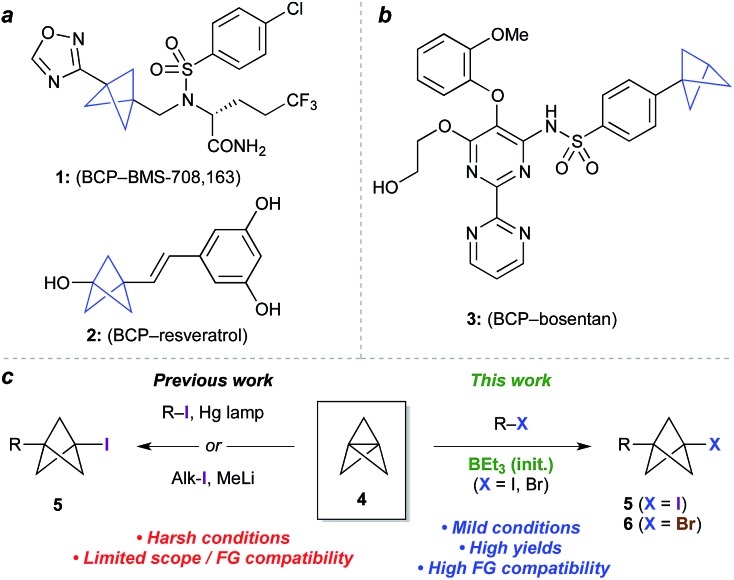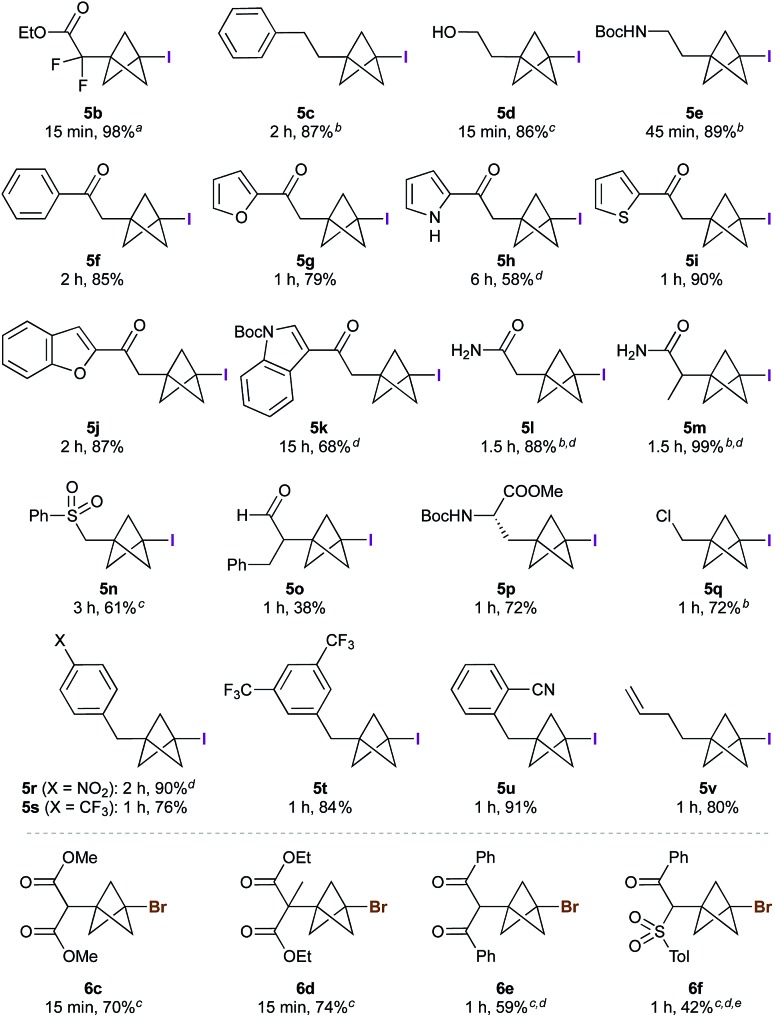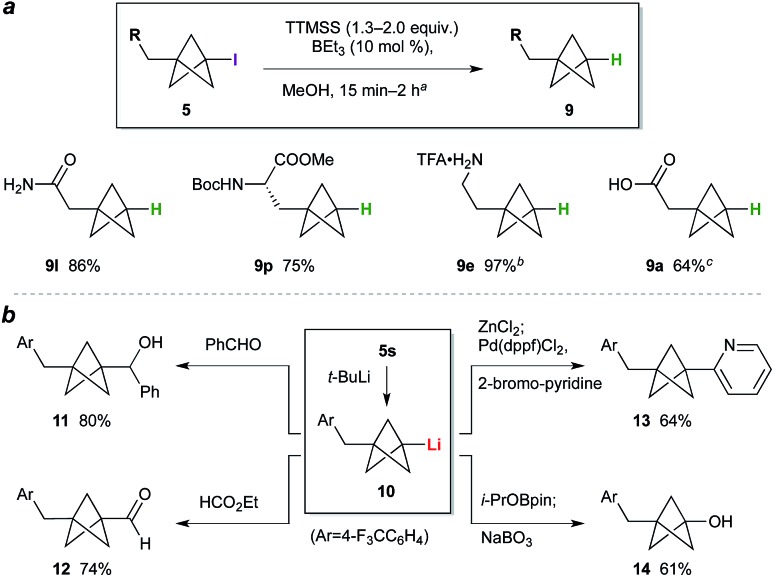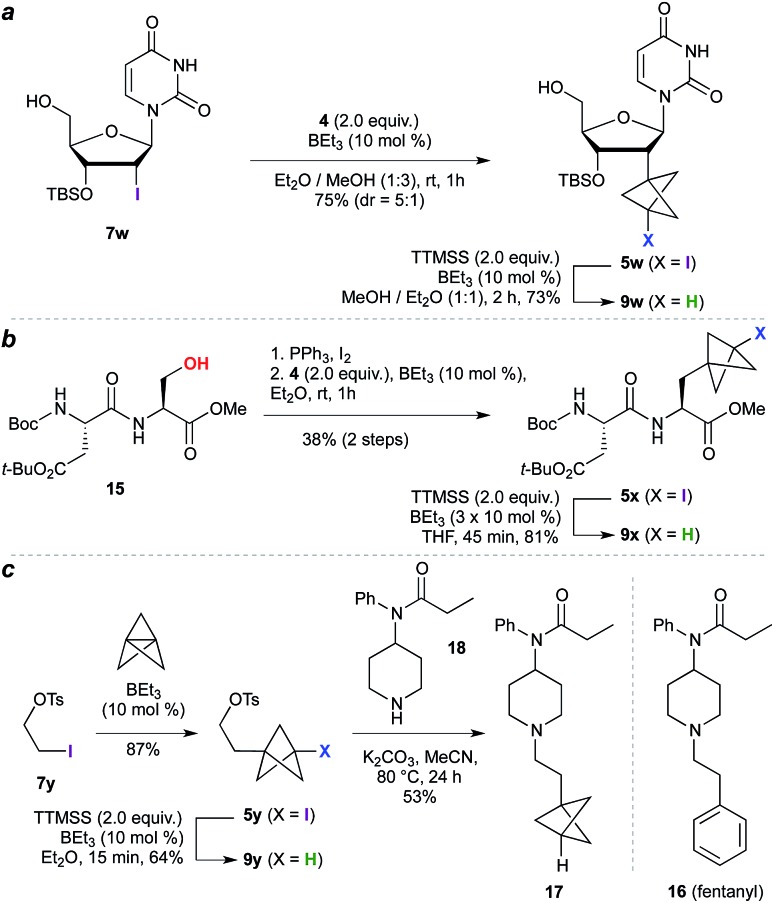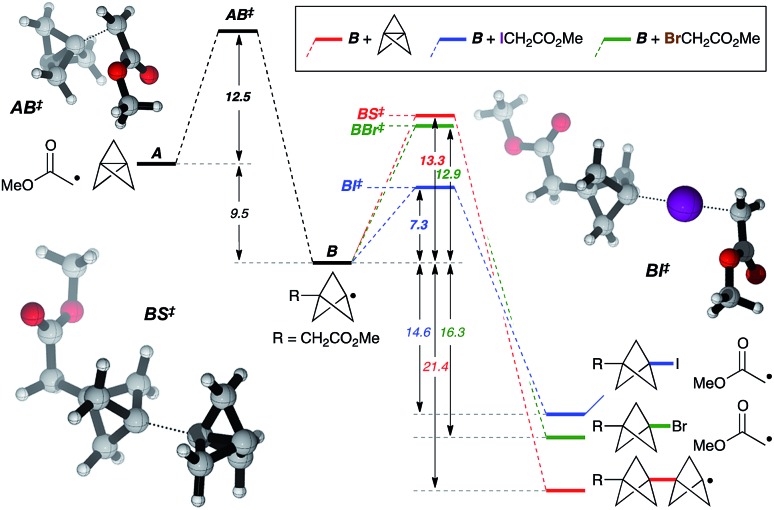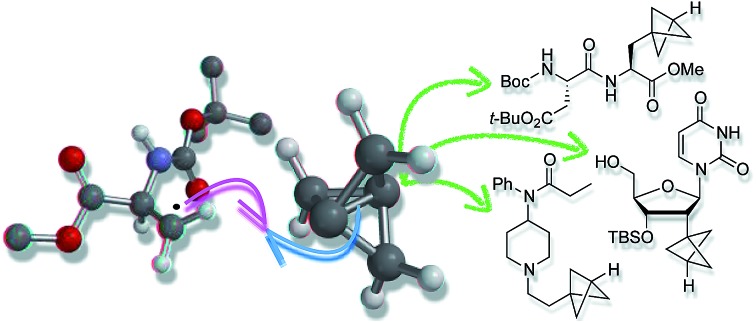 A wide range of halogenated bicyclo[1.1.1]pentanes are accessed by functional group tolerant radical ring-opening of tricyclo[1.1.1.01,3]pentane, using triethylborane as initiator.
A wide range of halogenated bicyclo[1.1.1]pentanes are accessed by functional group tolerant radical ring-opening of tricyclo[1.1.1.01,3]pentane, using triethylborane as initiator.
Abstract
Bicyclo[1.1.1]pentanes (BCPs) are important bioisosteres of 1,4-disubstituted arenes, tert-butyl and acetylenic groups that can impart physicochemical benefits on drug candidates. Here we describe the synthesis of BCPs bearing carbon and halogen substituents under exceptionally mild reaction conditions, via triethylborane-initiated atom-transfer radical addition ring-opening of tricyclo[1.1.1.01,3]pentane (TCP) with alkyl halides. This chemistry displays broad substrate scope and functional group tolerance, enabling application to BCP analogues of biologically-relevant targets such as peptides, nucleosides, and pharmaceuticals. The BCP halide products can be converted to the parent phenyl/tert-butyl surrogates through triethylborane-promoted dehalogenation, or to other derivatives including carbonyls, alcohols, and heterocycles.
Introduction
Bioisosteres are important motifs in drug design,1 enabling the expansion of chemical and intellectual property space2 while also improving biological profiles relative to the parent functionality. Bicyclo[1.1.1]pentanes (BCPs) have shown particularly impressive results in this field as surrogates for 1,4-disubstituted arenes, tert-butyl, and alkyne groups, imparting desirable properties such as membrane permeability, solubility and metabolic stability.3,4 Examples include BCP analogues of the γ-secretase inhibitor BMS-708, 163 (1, Fig. 1a)5 and resveratrol (2),6 in which the BCP serves as a bioisostere for a p-substituted arene due to its comparable positioning of substituents; and of the pulmonary arterial hypertension agent bosentan (3, Fig. 1b), where a monosubstituted BCP replaces a tert-butyl group.7,8 Despite these favourable attributes, access to carbon-substituted BCPs remains a challenge. Their synthesis typically relies on multistep sequences from a small number of available precursors,9 or requires relatively harsh conditions,10 necessitating early-stage introduction of the BCP and limiting functional group tolerance.
Fig. 1. (a) Bicyclo[1.1.1]pentanes (BCPs) as 1,4-disubstituted arene bioisosteres. (b) BCP as a tert-butyl bioisostere. (c) Approaches to 1-halo-3-substituted BCPs in previous and current work.
The BCP system is most commonly accessed through ‘strain release’11 reactions of tricyclo[1.1.1.01,3]pentane 4 (TCP),12 where in addition to classical approaches,3,13 recent work has seen the development of elegant methods for the synthesis of heteroatom-substituted BCPs.11,14 The insertion of TCP into C–X bonds would offer an appealing entry to carbon-substituted BCPs, as well as the opportunity for further functionalization of the halide product (5, Fig. 1c).15 To date however, this process has only been achieved using highly activated reagents (e.g. CF3I),13 or by mercury lamp irradiation of an alkyl or aryl halide,10d,e or methyllithium-promoted alkyl halide addition.10b Despite the importance of these contributions, all display limitations in substrate scope, functional group compatibility, or scalability, due to the constraints of the reaction conditions.
Atom transfer radical addition (ATRA) reactions using chemical initiators are an attractive alternative for TCP ring opening, but previously required a large excess of the radical precursor, or suffered from the formation of oligomeric ‘staffane’ byproducts due to multiple insertions into TCP.10d,13 Building on our studies of radical-mediated nucleoside alkynylation,16 we questioned whether triethylborane could serve as an effective initiator17 for the synthesis of 1-halo-3-substituted bicyclopentanes (Fig. 1c). Here we report the development of this method as an efficient and highly functional group tolerant route to halogenated BCPs, the utility of which are illustrated through various derivatizations. Importantly, the mild conditions of this chemistry allow the synthesis of bicyclopentanes that could not be accessed using other methods, and open up opportunities for the late-stage functionalization of more complex molecules.
Results and discussion
We began our studies using ethyl iodoacetate 7a, and were delighted to observe complete reaction in just 15 min at room temperature using 1.3 equivalents of TCP and 10 mol% triethylborane (1 M in hexane), with the product iodide 5a isolated in 83% yield (Table 1, entry 1). A mild exotherm was observed on addition of triethylborane to the reaction, which could be avoided by reducing the temperature (entry 2). The amount of initiator could be decreased to 1 mol% without detriment (entries 2–5), and the quantity of TCP could also be lowered (to 1.1 equiv.), affording 5a in 92% yield (entry 6). Successful reaction was similarly observed using TCP as a solution in dibutyl ether (0.19 M), which is significant for industrial applications (entry 7). The presence of triethylborane proved crucial, as reactions run in its absence failed to reach completion in the dark or light (entries 8 and 9).18 Importantly, no staffane byproducts were observed under the optimized conditions (entry 6).
Table 1. Optimization of triethylborane-promoted tricyclopentane ring-opening.

| ||||||
| Entry | Substrate | x (equiv.) | y (mol%) | T | t | Yield a (%) |
| 1 | 7a | 1.3 | 10 | rt | 15 min | 83 |
| 2 | 7a | 1.3 | 10 | 0 °C | 15 min | 87 |
| 3 | 7a | 1.3 | 5 | 0 °C | 15 min | 89 |
| 4 | 7a | 1.3 | 1 | 0 °C | 15 min | 95 |
| 5 | 7a | 1.3 | 0.5 | 0 °C | 15 min | (67 : 33) |
| 6 | 7a | 1.1 | 1 | 0 °C | 15 min | 92 |
| 7 | 7a | 2.0 | 10 | rt | 16 h | 98 b |
| 8 | 7a | 2.0 | 0 | rt | 20 h | (60 : 40) c |
| 9 | 7a | 2.0 | 0 | rt | 20 h | (33 : 67) |
| 10 | 8a | 1.3 | 10 | rt | 20 h | 47 d |
| 11 | 8b | 1.3 | 10 | rt | 15 min | 67 |
| 12 | 8b | 1.3 | 10 | 0 °C | 15 min | 73 |
| 13 | 8b | 1.3 | 1 | 0 °C | 15 min | (60 : 40) |
aIsolated yields. Figures in parentheses indicate incomplete reactions, and the ratio of starting material to product as judged by 1H NMR spectroscopic analysis of the crude reaction mixture.
bReaction carried out in Bu2O (0.19 M).
cReaction carried out in the dark.
dIsolated as a 6 : 1 mixture of 6a : staffane.
Use of the equivalent bromoacetate 8a led to incomplete conversion, or significant staffane formation (entry 10).19 However, we were pleased to find that 2-bromo-2-nitropropane 8b underwent rapid reaction with 1.3 equivalents of TCP to afford 6b in 67% yield (entry 11).20 As with 7a, full conversion was maintained on cooling the reaction to 0 °C (73%, entry 12); however, lowering the quantity of triethylborane resulted in incomplete reaction (entry 13). The success of substrate 8b presumably reflects a more efficient bromine atom abstraction by the bicyclopentyl radical in the propagation step compared to ester 8a, due to the greater stability of the tertiary nitro-substituted radical.
The scope of the triethylborane-initiated ATRA was next explored using organohalides featuring a variety of functional groups (Fig. 2).21 While the optimized conditions (Table 1, entry 6) translated smoothly to ethyl difluoroiodoacetate, giving bench-stable BCP 5b in 98% yield,22 incomplete reactions were observed in other cases. To ensure consistency, the substrate screen was therefore conducted using 10 mol% BEt3 and 1.3–2.0 equivalents of TCP at either 0 °C or room temperature, according to the requirements of the substrate. Alkyl iodides showed excellent reactivity, tolerating groups such as hydroxyls and carbamates (5c–e). α-Iodoketones gave high yields across a range of substrates, including heteroaromatics (5f–k). Other electron-withdrawing groups such as amides and sulfones also proved viable (5l–5n),20 including the sensitive but potentially valuable aldehyde 5o. The formation of 5p is particularly notable due to the potential utility of BCP analogues of amino acids;23 no racemization was observed in this reaction. Even chloroiodomethane was found to be a suitable substrate, delivering chloromethyl BCP 5q in good yield. Benzyl halides also underwent smooth reaction, providing electron-withdrawing substituents were present on the arene (which presumably accelerates the halide abstraction step from the intermediate BCP radical, 5r–5u).20 The involvement of radical intermediates was supported by the use of (iodomethyl)cyclopropane, which exclusively gave the ring-opened product 5v. Finally, other electron-deficient bromides proved suitable partners, affording products 6c–f in short reaction times; for these substrates, the presence of two electron-withdrawing groups proved essential for efficient bromine atom abstraction.
Fig. 2. Synthesis of 1-iodo- and 1-bromo-3-substituted BCPs. All reactions performed using 2 equiv. tricyclo[1.1.1.01,3]pentane (TCP) and 10 mol% BEt3 (1 M in hexane) at room temperature, unless indicated otherwise. a1.1 equiv. TCP, 1 mol% BEt3, 0 °C. b1.3 equiv. TCP, rt. c1.3 equiv. TCP, 0 °C. dCo-solvent added to solubilize the substrate: MeOH for 5m, n; CH2Cl2 for 5h, k, r and 6e, f. e5% staffane observed.
While the BCP iodide products are stable towards storage at –20 °C (particularly if crystalline), in some cases gradual coloration was observed at ambient temperature. Deiodination was expected to enhance BCP stability, and would simultaneously access the parent phenyl/tert-butyl bioisostere. We questioned whether triethylborane could again be used as initiator for this C–I bond reduction; pleasingly, the use of 1.3 equivalents of tris(trimethylsilyl)silane (TTMSS) as a non-toxic hydrogen atom source24 and 10 mol% BEt3 effected smooth deiodination of various BCP iodides (Scheme 1a), giving amide 9l, a BCP analogue of phenylalanine (9p), and trifluoroacetate salt 9e, the free base of the latter being a BCP equivalent of the monoaminergic neuromodulator phenethylamine. Given the use of the same initiator for both radical processes, a one-pot reaction sequence was also performed in which BCP 9a was prepared directly from 7a in a single operation (64%). Transformation of the iodide into substituents other than hydrogen was also explored (Scheme 1b): lithiation of 5s,10b followed by reaction of the resulting organolithium 10 with benzaldehyde or ethyl formate, gave alcohol 11 and aldehyde 12 respectively. Alternatively, transmetalation to the organozinc and cross-coupling with 2-bromopyridine afforded pyridyl BCP 13 (64%).10a,b Pleasingly, the synthesis of a phenol bioisostere6 (14) could also be accomplished by a borylation quench, followed by oxidation with sodium perborate.
Scheme 1. (a) BCP deiodination. aSee the ESI† for experimental conditions for each substrate. bDeiodination product from 5e treated with CF3CO2H (yield over two steps). cIodide 7a processed through TCP ring opening, deiodination, and hydrolysis (NaOH, MeOH) without purification. (b) BCP iodide functionalization.
The high functional group tolerance and mild reaction conditions suggested that this methodology could be exploited in the functionalization of more complex organic molecules. For example, 2′-iodouridine derivative 7w (Scheme 2a) underwent successful ATRA reaction to generate 5w (75%, 5 : 1 dr), with deiodination delivering the 2′-deoxy-2′-BCP nucleoside 9w (73%). More generally, the availability of iodides from hydroxyl groups provides a multitude of opportunities for bioisostere installation: Appel reaction of the aspartate–serine dipeptide 15 (Scheme 2b) afforded iodide 5x, which on ATRA reaction and subsequent TTMSS reduction generated BCP-functionalized dipeptide 9x. This sequence corresponds to a three step conversion of a serine residue to a potential phenylalanine equivalent, and here delivers a BCP analogue of aspartame. Finally, we targeted application of the methodology to the opioid receptor agonist fentanyl (16, Scheme 2c). Synthesis of its BCP analogue 17 was accomplished from iodotosylate 7y where, pleasingly, the primary alkyl tosylate was tolerated in the initial high-yielding TCP ring-opening (87%). TTMSS-mediated reduction of the iodide product 5y afforded the useful BCP building block 9y, which underwent alkylation with norfentanyl 18 to afford fentanyl analogue 17 (53%).20
Scheme 2. Synthesis of nucleoside, dipeptide, and pharmaceutical BCP analogues.
While the mechanism of this C–X addition reaction likely involves a radical pathway, not least due to the cyclopropane ring fragmentation observed in the formation of 5v (Fig. 2), it is not immediately obvious why reaction propagation via halogen atom abstraction should proceed so efficiently, with avoidance of staffane formation. To explore this, we examined the reaction of α-iodo- and α-bromomethyl acetate with TCP from a theoretical perspective at the ROM062x/def2tzvp level25 (Fig. 3, in vacuo).26 Exergonic addition of the α-carbonyl radical to TCP (A) was found to proceed via transition state AB‡ (ΔG‡ = 12.5 kcal mol–1). Reaction of the resultant bicyclopentyl radical B with α-iodo- or α-bromomethyl acetate (iodine/bromine atom transfer, BI‡/BBr‡), or with TCP (leading to a staffane radical, BS‡), was computed. Predicted activation barriers of 7.3 and 13.3 kcal mol–1 for iodine atom abstraction and TCP capture respectively suggest that the former productive propagation step is significantly favoured over oligomerization (ΔΔG‡ = 6.1 kcal mol–1). In contrast, a barrier of 12.9 kcal mol–1 for bromine atom abstraction indeed suggests staffane formation to be competitive (ΔΔG‡ = 0.4 kcal mol–1), which is consistent with experimental observations (Table 1), and reflects the influence of C–X bond strength in the propagation phase of the reaction.
Fig. 3. Theoretical analysis of the reaction pathway. Calculations carried out at the ROMO62x/def2tzvp level. Relative energies are in kcal mol–1. See the ESI for details.† .
Conclusions
In conclusion, we have developed an efficient triethylborane-promoted radical-based method to synthesize 1-halo-3-substituted bicyclo[1.1.1]pentanes from readily available iodide and bromide starting materials. The reaction displays broad substrate scope, and functional group compatibility that is not achievable using other methods, enabling application to the functionalization of complex substrates such as nucleosides, peptides and drug-like molecules. The carbon–halogen bond is easily reduced under similarly mild conditions to reveal the parent bioisostere, or functionalized via methods such as Negishi cross-coupling or oxidation. In addition to offering a new entry to highly-functionalized bicyclopentanes, the C–X bond offers much potential for subsequent transformations; investigations to this end are underway.
Conflicts of interest
There are no conflicts to declare.
Supplementary Material
Acknowledgments
D. F. J. C. and S. J. M. are grateful to the EPSRC Centre for Doctoral Training in Synthesis for Biology and Medicine (EP/L015838/1) for studentships, generously supported by AstraZeneca, Diamond Light Source, Defence Science and Technology Laboratory, Evotec, GlaxoSmithKline, Janssen, Novartis, Pfizer, Syngenta, Takeda, UCB and Vertex. E. A. A. and C. A. thank the EPSRC for funding (EP/M019195/1). A. B. D. thanks the Heinrich Hertz Foundation for a Fellowship. We also thank the University of Oxford Advanced Research Computing (ARC) facility (DOI: 10.5281/zenodo.22558).
Footnotes
†Electronic supplementary information (ESI) available. CCDC 1825056–1825060. For ESI and crystallographic data in CIF or other electronic format see DOI: 10.1039/c8sc01355a
References
- (a) Meanwell N. A. Chem. Res. Toxicol. 2016;29:564–616. doi: 10.1021/acs.chemrestox.6b00043. [DOI] [PubMed] [Google Scholar]; (b) Meanwell N. A. J. Med. Chem. 2011;54:2529–2591. doi: 10.1021/jm1013693. [DOI] [PubMed] [Google Scholar]; (c) Patani G. A., LaVoie E. J. Chem. Rev. 1996;96:3147–3176. doi: 10.1021/cr950066q. [DOI] [PubMed] [Google Scholar]
- Lovering F., Bikker J., Humblet C. J. Med. Chem. 2009;52:6752–6756. doi: 10.1021/jm901241e. [DOI] [PubMed] [Google Scholar]
- (a) Dilmaç A. M., Spuling E., de Meijere A., Bräse S. Angew. Chem., Int. Ed. 2017;56:5684–5718. doi: 10.1002/anie.201603951. [DOI] [PubMed] [Google Scholar]; (b) Levin M. D., Kaszynski P., Michl J. Chem. Rev. 2000;100:169–234. doi: 10.1021/cr990094z. [DOI] [PubMed] [Google Scholar]; (c) Wiberg K. B. Chem. Rev. 1989;89:975–983. [Google Scholar]
- (a) For recent examples of other small ring compounds as bioisosteres, see: Kirichok A. A., Shton I., Kliachyna M., Pishel I., Mykhailiuk P. K., Angew. Chem., Int. Ed., 2017, 56 , 8865 –8869 . [DOI] [PubMed] [Google Scholar]; (b) Lassalas P., Oukoloff K., Makani V., James M., Tran V., Yao Y., Huang L., Vijayendran K., Monti L., Trojanowski J. Q., Lee V. M. Y., Kozlowski M. C., Smith A. B., Brunden K. R., Ballatore C. ACS Med. Chem. Lett. 2017;8:864–868. doi: 10.1021/acsmedchemlett.7b00212. [DOI] [PMC free article] [PubMed] [Google Scholar]; (c) Mukherjee P., Pettersson M., Dutra J. K., Xie L., am Ende C. W. ChemMedChem. 2017;12:1574. doi: 10.1002/cmdc.201700333. [DOI] [PubMed] [Google Scholar]; (d) Auberson Y. P., Brocklehurst C., Furegati M., Fessard T. C., Koch G., Decker A., La Vecchia L., Briard E. ChemMedChem. 2017;12:590–598. doi: 10.1002/cmdc.201700082. [DOI] [PubMed] [Google Scholar]; (e) Chalmers B. A., Xing H., Houston S., Clark C., Ghassabian S., Kuo A., Cao B., Reitsma A., Murray C.-E. P., Stok J. E., Boyle G. M., Pierce C. J., Littler S. W., Winkler D. A., Bernhardt P. V., Pasay C., De Voss J. J., McCarthy J., Parsons P. G., Walter G. H., Smith M. T., Cooper H. M., Nilsson S. K., Tsanaktsidis J., Savage G. P., Williams C. M. Angew. Chem., Int. Ed. 2016;55:3580–3585. doi: 10.1002/anie.201510675. [DOI] [PubMed] [Google Scholar]; (f) Bull J. A., Croft R. A., Davis O. A., Doran R., Morgan K. F. Chem. Rev. 2016;116:12150–12233. doi: 10.1021/acs.chemrev.6b00274. [DOI] [PubMed] [Google Scholar]
- Stepan A. F., Subramanyam C., Efremov I. V., Dutra J. K., O'Sullivan T. J., DiRico K. J., McDonald W. S., Won A., Dorff P. H., Nolan C. E., Becker S. L., Pustilnik L. R., Riddell D. R., Kauffman G. W., Kormos B. L., Zhang L., Lu Y., Capetta S. H., Green M. E., Karki K., Sibley E., Atchison K. P., Hallgren A. J., Oborski C. E., Robshaw A. E., Sneed B., O'Donnell C. J. J. Med. Chem. 2012;55:3414–3424. doi: 10.1021/jm300094u. [DOI] [PubMed] [Google Scholar]
- Goh Y. L., Cui Y. T., Pendharkar V., Adsool V. A. ACS Med. Chem. Lett. 2017;8:516–520. doi: 10.1021/acsmedchemlett.7b00018. [DOI] [PMC free article] [PubMed] [Google Scholar]
- Westphal M. V., Wolfstädter B. T., Plancher J.-M., Gatfield J., Carreira E. M. ChemMedChem. 2015;10:461–469. doi: 10.1002/cmdc.201402502. [DOI] [PubMed] [Google Scholar]
- (a) For other recent examples of BCPs in medicinal chemistry, see: Measom N. D., Down K. D., Hirst D. J., Jamieson C., Manas E. S., Patel V. K., Somers D. O., ACS Med. Chem. Lett., 2017, 8 , 43 –48 . [DOI] [PMC free article] [PubMed] [Google Scholar]; (b) Nicolaou K. C., Yin J., Mandal D., Erande R. D., Klahn P., Jin M., Aujay M., Sandoval J., Gavrilyuk J., Vourloumis D. J. Am. Chem. Soc. 2016;138:1698–1708. doi: 10.1021/jacs.5b12557. [DOI] [PubMed] [Google Scholar]; (c) Pellicciari R., Filosa R., Fulco M. C., Marinozzi M., Macchiarulo A., Novak C., Natalini B., Hermit M. B., Nielsen S., Sager T. N., Stensbøl T. B., Thomsen C. ChemMedChem. 2006;1:358–365. doi: 10.1002/cmdc.200500071. [DOI] [PubMed] [Google Scholar]
- (a) Kaszynski P., Michl J. J. Org. Chem. 1988;53:4593–4594. [Google Scholar]; (b) 1-azido-3-iodo BCP: Wiberg K. B., McMurdie N., J. Am. Chem. Soc., 1994, 116 , 11990 –11998 . [Google Scholar]
- (a) Makarov I. S., Brocklehurst C. E., Karaghiosoff K., Koch G., Knochel P. Angew. Chem., Int. Ed. 2017;56:12774–12777. doi: 10.1002/anie.201706799. [DOI] [PubMed] [Google Scholar]; (b) Messner M., Kozhushkov S. I., de Meijere A. Eur. J. Org. Chem. 2000:1137. [Google Scholar]; (c) Della E. W., Taylor D. K. J. Org. Chem. 1994;59:2986–2996. [Google Scholar]; (d) Kaszynski P., Friedli A. C., Michl J. J. Am. Chem. Soc. 1992;114:601–620. [Google Scholar]; (e) Kaszynski P., McMurdie N. D., Michl J., J. Org. Chem., 1991, 56 , 307 –316 , ; to our knowledge only esters and a ketone have been shown to be tolerated under mercury lamp irradiation, and only tetrahydropyranyl ethers under MeLi promoted TCP ring opening . [Google Scholar]
- (a) Gianatassio R., Lopchuk J. M., Wang J., Pan C.-M., Malins L. R., Prieto L., Brandt T. A., Collins M. R., Gallego G. M., Sach N. W., Spangler J. E., Zhu H., Zhu J., Baran P. S. Science. 2016;351:241. doi: 10.1126/science.aad6252. [DOI] [PMC free article] [PubMed] [Google Scholar]; (b) Lopchuk J. M., Fjelbye K., Kawamata Y., Malins L. R., Pan C.-M., Gianatassio R., Wang J., Prieto L., Bradow J., Brandt T. A., Collins M. R., Elleraas J., Ewanicki J., Farrell W., Fadeyi O. O., Gallego G. M., Mousseau J. J., Oliver R., Sach N. W., Smith J. K., Spangler J. E., Zhu H., Zhu J., Baran P. S. J. Am. Chem. Soc. 2017;139:3209–3226. doi: 10.1021/jacs.6b13229. [DOI] [PMC free article] [PubMed] [Google Scholar]
- Mondanaro K. R., Dailey W. P., Org. Synth., 1998, 75 , 98 , . For a more recent preparation using PhLi see ref. 11a Appropriate precautions should be taken in the preparation of 4 due to the need for relatively large volumes of organolithium solutions . [Google Scholar]
- Wiberg K. B., Waddell S. T. J. Am. Chem. Soc. 1990;112:2194–2216. [Google Scholar]
- (a) Bär R. M., Kirschner S., Nieger M., Bräse S. Chem.–Eur. J. 2018;24:1373–1382. doi: 10.1002/chem.201704105. [DOI] [PubMed] [Google Scholar]; (b) Kanazawa J., Maeda K., Uchiyama M. J. Am. Chem. Soc. 2017;139:17791–17794. doi: 10.1021/jacs.7b11865. [DOI] [PubMed] [Google Scholar]; (c) Bunker K., Guo C., Grier M., Hopkins C., Pinchman J., Slee D., Huang P. Q. and Kahraman M., WO Pat., 2016/044331, 2016.; (d) Goh Y. L., Adsool V. A. Org. Biomol. Chem. 2015;13:11597–11601. doi: 10.1039/c5ob02066b. [DOI] [PubMed] [Google Scholar]; (e) Thirumoorthi N. T., Shen C. J., Adsool V. A. Chem. Commun. 2015;51:3139–3142. doi: 10.1039/c4cc09655j. [DOI] [PubMed] [Google Scholar]; (f) Goh Y. L., Tam E. K. W., Bernardo P. H., Cheong C. B., Johannes C. W., William A. D., Adsool V. A. Org. Lett. 2014;16:1884–1887. doi: 10.1021/ol500635p. [DOI] [PubMed] [Google Scholar]; (g) Bunker K. D., Sach N. W., Huang Q., Richardson P. F. Org. Lett. 2011;13:4746–4748. doi: 10.1021/ol201883z. [DOI] [PubMed] [Google Scholar]
- (a) Adcock J. L., Gakh A. A., J. Org. Chem., 1992, 57 , 6206 –6210 , ; see also ref. 9a, 10b and 14c . [Google Scholar]; (b) Mazal C., Paraskos A. J., Michl J. J. Org. Chem. 1998;63:2116–2119. [Google Scholar]
- (a) Haugland M. M., El-Sagheer A. H., Porter R. J., Peña J., Brown T., Anderson E. A., Lovett J. E. J. Am. Chem. Soc. 2016;138:9069–9072. doi: 10.1021/jacs.6b05421. [DOI] [PubMed] [Google Scholar]; (b) Sukeda M., Ichikawa S., Matsuda A., Shuto S. J. Org. Chem. 2003;68:3465–3475. doi: 10.1021/jo0206667. [DOI] [PubMed] [Google Scholar]; (c) Sukeda M., Ichikawa S., Matsuda A., Shuto S. Angew. Chem., Int. Ed. 2002;41:4748–4750. doi: 10.1002/anie.200290037. [DOI] [PubMed] [Google Scholar]
- (a) Curran D. P., McFadden T. R. J. Am. Chem. Soc. 2016;138:7741–7752. doi: 10.1021/jacs.6b04014. [DOI] [PubMed] [Google Scholar]; (b) Ollivier C., Renaud P. Chem. Rev. 2001;101:3415–3434. doi: 10.1021/cr010001p. [DOI] [PubMed] [Google Scholar]
- While the reaction of 7a was not affected if conducted in degassed solvent under a nitrogen atmosphere (<15 min), the equivalent formation of 5s (Table 1) was significantly retarded, requiring 20 h reaction time to reach completion. We believe this supports a standard oxygen-mediated initiation mechanism. See ref. 17, and the ESI.
- For Et3B-promoted ATRA using 8a, see: Yorimitsu H., Shinokubo H., Matsubara S., Oshima K., Omoto K., Fujimoto H., J. Org. Chem., 2001, 66 , 7776 –7785 . [DOI] [PubMed] [Google Scholar]
- Low temperature single crystal X-ray diffraction data were 40 collected for 5m, 5r, 5s, 6b and 17 using a (Rigaku) Oxford Diffraction SuperNova A diffractometer. Raw frame data were collected and reduced using CrysAlisPro. The structures were solved using SuperFlip [ Palatinus L., Chapuis G., J. Appl. Crystallogr., 2007, 40 , 786 –790 , ] and refined using CRYSTALS [ Betteridge P. W., Carruthers J. R., Cooper R. I., Prout K., Watkin D. J., J. Appl. Crystallogr., 2003, 36 , 1487, Cooper R. I., Thompson A. L., Watkin D. J., J. Appl. Crystallogr., 2010, 43 , 1100 –1107 , ]. See the ESI (CIF). CCDC ; 1825056–1825060 contain the crystallographic data for this paper. . [Google Scholar]
- See the ESI for a discussion of substrates and functional groups that were not tolerated, or led to incomplete conversion, or significant staffane formation
- This reaction was also conducted on a 5.00 mmol scale, which afforded 5b in 94% yield (1.50 g)
- (a) For examples of BCP amino acids, see ref. 4c, 8c, and: ; (b) Pritz S., Pätzel M., Szeimies G., Dathe M., Bienert M. Org. Biomol. Chem. 2007;5:1789–1794. doi: 10.1039/b702134h. [DOI] [PubMed] [Google Scholar]; (c) For additional examples, see: Pellicciari R., Raimondo M., Marinozzi M., Natalini B., Costantino G., Thomsen C., J. Med. Chem., 1996, 39 , 2874 –2876 . [DOI] [PubMed] [Google Scholar]
- (a) (b). (a) TTMSS has been employed in the reduction of BCP halides using AIBN as an initiator, see ref. 14c and e. Tributyltin hydride has also been used as the reducing agent, see ref. 10a; Thirumoorthi N. T., Adsool V. A. Org. Biomol. Chem. 2016;14:9485–9489. doi: 10.1039/c6ob01799a. [DOI] [PubMed] [Google Scholar]
- (a) Weigend F., Ahlrichs R. Phys. Chem. Chem. Phys. 2005;7:3297–3305. doi: 10.1039/b508541a. [DOI] [PubMed] [Google Scholar]; (b) Zhao Y., Truhlar D. G. Theor. Chem. Acc. 2008;120:215–241. [Google Scholar]
- For appropriateness of the method chosen, see ref. 14b, and the ESI.
Associated Data
This section collects any data citations, data availability statements, or supplementary materials included in this article.



